Dead Dogs, Dead Cows and Dead Men in 2 Samuel 19 - 20
Am grateful for the dogs in my life, none of whom I need to feed, bathe, walk or groom; my sole responsibilities vis-à-vis the cuddly canines being to play with them, kiss them unhygienically on their wet noses and use them as furry footrests during bible study.
Almost every week, we are greeted at the door by an ecstatic golden retriever, chew toy already in mouth, anticipating several hours of play time. And some weekends, there are three minature schnauzers completely mad for a stuffed (and well-chewed) puffer fish.
(Would have said that I was grateful for the babies in my life as well but, frankly, they are quite useless as footrests. Plus I don't kiss them.)
It was a source of great amusement to see that the prevailing turn of phrase in the Second Book of Samuel was "dead dog". "What is your servant, that you should show regard for a dead dog such as I?" asked Mephibosheth humbly of King David (2 Samuel 9:8). "Why should this dead dog curse my lord the king? Let me go over and take off his head." says Abishai of the disgruntled Shimei (2 Samuel 16:9). Being a dog and being dead was quite the pits, it seems.
In uni in the English countryside, the choice insult was "stupid cow". Biblical cows, it appears, were not stupid. The worst they got was thin and ugly (Genesis 41), unless of course they came from Bashan (Amos 4:1).
In any case, am also greatly fond of cows, this time especially of dead ones. During the sporadic days of rainy respite from the heat, we've been able to take side trips from wimpy fruit-centric meals to chow down on some dead cow.
Corned beef hash based on a recipe from Aun at Chubby Hubby. Had my corned beef sliced instead of chopped into chunks to increase the surface area available for crust-formation.
But corned beef hash didn't quite fulfil dead cow desires, so on we went.
At Ristorante Pietrasanta, sitting outside the renovated ex-Judo Federation headquarters in Wessex Village lined with herbs in plant boxes and hanging lamps, we had eyes only for one sort of meat. The table next door said this place'd been recommended by the chef at Valentino's and expected good things. The snails were well-pan-fried and appeared fully-infused with rich garlicky stewed tomato sauce. The osso buco, veal shank slow-cooked for four hours in un-traditional tomato-based stew, was tender and tasty though lacking in marrow. The tenderloin was fresh and tender but overwhelmed by crushed black pepper. Service staff ranged from efficient and knowledgeable (the English waitress) to grumpy and ignorant (the mainland Chinese waitress).
More dead cow beckoned. Heston "Fat Duck" Blumenthal in In Search of Perfection had suggested the use of blue-cheese-infused butter in cooking steak to approximate something of the spectacularly nutty, cheesy character of aged beef. Here's his 18-hour recipe for the perfect steak.
Some weeks ago, we were at Brewerkz Indoor Stadium and I was chuffed to find a blue cheese burger on the menu. Everyone to whom I'd spoken about blue-cheese-infused butter had gagged but the person who had more than half the shared burger said it was delish. There was hope, after all, for the combination in polite company. (Though, given that we'd have been equally happy sitting around with beers watching football as going for the MayDay concert if someone had forgotten the tickets, not sure how polite the company really was.)
Some days later, I attempted a ribeye topped with Roaring Forties Blue Cheese just after it'd been taken off the fire. The cheese, being less mouldering-wet-sock-like than other blue cheeses did spectacularly well with the meat. However, if the definition of a good steak is one that is chargrilled on the outside but juicy and richly tender on the inside, this one didn't make it. The meat, though still pink on the inside was nevertheless still slightly tough.
A browse through Shirley Corriher's Cookwise and Peter Barham's The Science of Cooking yielded a smorgasbord of things that could have affected the tenderness and flavour of the final product. I probably scored top marks in them all. This is probably only interesting to me and to the cow. Oh wait, the cow just died of boredom:
But whatever his motivations, David's first task to Amasa was to have him rally the men of Judah to David within three days to fight against the newest rebel, Sheba and the rest of the ten tribes of Israel (2 Samuel 20:4). But Amasa dallied and Sheba was getting near fortified cities. There was no time to be lost so David instructed Joab's brother Abishai (note, and still not Joab himself) to pursue Sheba. Assumedly, Joab was part of the contingent. He comes upon the tardy Amasa at a great stone landmark in Gideon and, well, the Bible tells it best:
2 Samuel 20 ends with Joab in command of all the army of Israel again.
There is much to understand from these two chapters - the reactions of Shimei, Mephibosheth and Barzillai to the returning king and David's demonstration of the restoration of his reign and kingship, and the folly of opposing God's plan and God's king, for example. But am intrigued by Joab.
The narrator of 2 Samuel makes no comment on Joab's actions. But David on his deathbed did. In 1 Kings 2, David instructed his successor, Solomon:
Even more interesting is that David considered these murders a personal affront even though he was not himself harmed in any way. Having Abner and Amasa out of the way might in fact have made his reign as king more straightforward and secure. Most commentators suggest that David felt so strongly about these events because they threatened to destabilise his rule. People might think David an untrustworthy hypocrite for appearing to extend the olive branch to former enemies publicly but getting his commander-in-chief to off them privately.
Wonder if it would be too much of a stretch to say that if all sin is ultimately a sin against God, then it was also a sin against David, as God's representative ruler over his people. And so, to sin in the name of doing David's good/God's work/God's will was an affront to both David and God.
Also, I suppose in a similar way, to claim that sinning is alright in light of the greater good of ministry, eg. telling little white lies to get someone with proper theology elected to a position of greater influence or touting membership benefits to would-be converts never promised by God, is pretty perverted logic. Sinning in the name of doing God's work suggests that we don't trust God's word nor are we able to understand his view of the world. Sin is sin not because it just breaks a couple of arbitrary laws that can be held in abeyance once in a while when it is convenient to do so but that it goes against immutable laws that explain how God designed the universe to work and describe things that are of value to the unchanging Creator.
Pietrasanta The Italian Restaurant
5B Portsdown Road #01-03 Wessex Estate
E-mail: pietrasanta@singnet.com.sg
Tel: 6479 9521
_________________________________________
Almost every week, we are greeted at the door by an ecstatic golden retriever, chew toy already in mouth, anticipating several hours of play time. And some weekends, there are three minature schnauzers completely mad for a stuffed (and well-chewed) puffer fish.
(Would have said that I was grateful for the babies in my life as well but, frankly, they are quite useless as footrests. Plus I don't kiss them.)
It was a source of great amusement to see that the prevailing turn of phrase in the Second Book of Samuel was "dead dog". "What is your servant, that you should show regard for a dead dog such as I?" asked Mephibosheth humbly of King David (2 Samuel 9:8). "Why should this dead dog curse my lord the king? Let me go over and take off his head." says Abishai of the disgruntled Shimei (2 Samuel 16:9). Being a dog and being dead was quite the pits, it seems.
In uni in the English countryside, the choice insult was "stupid cow". Biblical cows, it appears, were not stupid. The worst they got was thin and ugly (Genesis 41), unless of course they came from Bashan (Amos 4:1).
In any case, am also greatly fond of cows, this time especially of dead ones. During the sporadic days of rainy respite from the heat, we've been able to take side trips from wimpy fruit-centric meals to chow down on some dead cow.
Corned beef hash based on a recipe from Aun at Chubby Hubby. Had my corned beef sliced instead of chopped into chunks to increase the surface area available for crust-formation.
But corned beef hash didn't quite fulfil dead cow desires, so on we went.
At Ristorante Pietrasanta, sitting outside the renovated ex-Judo Federation headquarters in Wessex Village lined with herbs in plant boxes and hanging lamps, we had eyes only for one sort of meat. The table next door said this place'd been recommended by the chef at Valentino's and expected good things. The snails were well-pan-fried and appeared fully-infused with rich garlicky stewed tomato sauce. The osso buco, veal shank slow-cooked for four hours in un-traditional tomato-based stew, was tender and tasty though lacking in marrow. The tenderloin was fresh and tender but overwhelmed by crushed black pepper. Service staff ranged from efficient and knowledgeable (the English waitress) to grumpy and ignorant (the mainland Chinese waitress).
More dead cow beckoned. Heston "Fat Duck" Blumenthal in In Search of Perfection had suggested the use of blue-cheese-infused butter in cooking steak to approximate something of the spectacularly nutty, cheesy character of aged beef. Here's his 18-hour recipe for the perfect steak.
Some weeks ago, we were at Brewerkz Indoor Stadium and I was chuffed to find a blue cheese burger on the menu. Everyone to whom I'd spoken about blue-cheese-infused butter had gagged but the person who had more than half the shared burger said it was delish. There was hope, after all, for the combination in polite company. (Though, given that we'd have been equally happy sitting around with beers watching football as going for the MayDay concert if someone had forgotten the tickets, not sure how polite the company really was.)
Some days later, I attempted a ribeye topped with Roaring Forties Blue Cheese just after it'd been taken off the fire. The cheese, being less mouldering-wet-sock-like than other blue cheeses did spectacularly well with the meat. However, if the definition of a good steak is one that is chargrilled on the outside but juicy and richly tender on the inside, this one didn't make it. The meat, though still pink on the inside was nevertheless still slightly tough.
A browse through Shirley Corriher's Cookwise and Peter Barham's The Science of Cooking yielded a smorgasbord of things that could have affected the tenderness and flavour of the final product. I probably scored top marks in them all. This is probably only interesting to me and to the cow. Oh wait, the cow just died of boredom:
Several books opined that in describing a piece of meat as tender, we mean, inter alia, that there is liquid between the fibres and that the proteins in the meat hold on to moisture. A piece of meat is tough when it is difficult to cut through and chew.There was a different sort of butchering going on in 2 Samuel 19 - 20. David, in reclaiming his kingdom, made Amasa commander-in-chief of his army in place of Joab (2 Samuel 19:13). Amasa had only recently been Absalom's own commander-in-chief (2 Samuel 17:25) leading the fight against David. Now that Absalom had been defeated, David might have meant this as a reconciliatory gesture towards Judah who'd supported Absalom in his rebellion against David?
Part of the Dead Cow
In general, meat is tough if it is a much-used muscle and tender if it is a little-used muscle. Therefore muscles like the legs, hips, shoulders and neck are tough and the muscles in the center of the back of the animal (rib and loin) are tender. Tougher muscles that are used a lot may contain more myoglobin and may be deeper red in colour but are also very flavourful.
I'd used a ribeye which had been on sale at at discount at the butcher's. It contained streaks of fat (marbling) which would have melted in the cooking, flavouring and tenderising the meat by creating liquid between the fibres.
Rigor
But there's only so much that the cut of the beef influences tenderness. The moisture-holding ability of the proteins is influenced by acidity. Changes in acidity of the meat before, during and after rigor may influence meat tenderness, so even muscles that should be tender can be made tough if they are not allowed to go through rigor and relax again under proper conditions.
Rigor takes place after death because all animal muscles have their own storage supply of glycogen or carbohydrates, which they burn for energy. This process creates lactic acid as a waste product. When circulation stops, blood no longer flows through the muscles, and this lactic acid is not removed. In addition to the protein myosin, muscles contain actin, which normally slides past the myosin during muscle movement. When lactic acide builds up in the muscles, the actin and myocin that normally slide past each other react chemically to form acto-myosin. This causes muscles to contract tightly and become "stiff as a board".
Eventually, though, the muscles relax again. The temperature and the species are the two main determinants of how long it takes muscles to go into rigor and how long they stay in that state. Rigor takes about a day to pass in beef, but only about 6 hours in pork and chicken. Fish can take a few hours to a few days depending on the species.
Going through rigor improves meat in several ways. First it greatly improves the texture; meat that does not go through rigor has a gummy texture. Second, the increase in acidity slows spoilage of meat and also enhances the water-holding ability of the meat proteins. Meat that has been allowed to go through rigor properly is juicier than meat that has not.
One thing that will prevent proper rigor is the animal's being under stress or working very hard just before slaughter. When that does happen, the animal's muscles will have used up their supply of glycogen or carbohydrates and lactic acid will not have formed. The resulting meat will therefore be less acidic, darker in colour and more easily spoiled.
Meat is usually hung at moderate temperatures (16°C) for 16 to 20 hours postmortem to enhance its tenderness and ensure its proceeding into rigor. The hanging is done to stretch out the muscles before the rigor sets in. if the muscles are allowed to contract as the rigor starts, the bonding of the actin and myosin is stronger and the meat is tougher. The temperature is kept moderate because rapid chilling of meat before it goes into rigor will toughen it.
So a dark, poor-textured piece of meat or one that should be tender but is very tough may have been processed poorly.
Aging
Meat also benefits greatly from aging after rigor – in both texture and falvour. Aged meat has a buttery texture and a more intense meaty flavour. Meat should be held at 1-2.2°C to control bacterial growth. An optimal aging period for beef is 11 days. Aging can be hastened by holding meat at a warmer temperature 21°C for 2 days under high humidity (85-90 percent) to prevent moisture loss and with ultraviolet light to control bacteria. The meat found in most markets is fast aged and gets a little additional aging during shipping and in the store.
Meat can be aged wet (sealed in cryovac) or dry (exposed to air). Nearly all meat today is wet aged. Because of the moisture and weight loss of costly meat, dry-aged prime beef is extremely expensive. Even if you are willing to pay the price, it is difficult to find – obtainable only from a handful of specialty suppliers. You can age meat in your refrigerator at home. Place the unwrapped meat on a rack over a dish that is lined with a paper towel and leave uncovered 2 to 7 days in your refrigerator which is between 2.2 -4.4°C. It will turn dark, and the surface will dry out. When you are ready to cook, cut away the dried surface area.
Tenderising
The physical methods of tenderising consist of cutting or tearing long meat fibers across the grain. They can be ground or sliced and carved. Muscle fibers can be as long as a foot. When meat is sliced with the grain (that is, parallel to those fibers) you have a long, tough, uninterrupted fiber that may be unchewable. The same piece of meat thinly sliced across the grain has only a tiny length of fibre (the thickness of a slice) and is easy to chew. Even tough cuts of meat can seem tender when thinly sliced across the grain.
Chemical tenderisers such as enzymes papain and chymopapin from papayas and ficin from figs attack muscle proteins and there is a fungal enzyme, Rhozyme P-11, that attacks meat. The fresh ginger rhizome contains a single enzyme that attacks both muscle and collagen. Bromelain from pinapple is more active toward collagen than muscle. Even honeydew contains enzymes that attack meat proteins. These tenderizers work only when in direct contact with the meat, so unless they are injected into the meat, only the surface can be tenderised.
Acid-based marindes both tenderise and add flavour. The acid causes the denaturation or unwinding of long proteins. Anything acidic can be used as marinade – wine, fruit juice, buttermilk, milk, yoghurt. Oils that contain emulsifiers (mono- and di- glycerides) penetrated deeper and faster, thus making better marinades. Extra-virgin olive oil contains monoglycerides which will penetrate deeper nad faster than pure oilive, canola, corn or soyabean oil.
Heating/Cooking
When muscle fibres are heated above about 40°C, the proteins start to denature, that is they change their shape irreversibly. In muscle proteins, this change of shape involves the proteins coiling up. This coiling process inevitably causes some contraction of the muscle. As the muscles contract in cooking, so pieces of meat contract along the direction of the muscle fibres and the meat becomes harder. The longer you cook, the progressively tougher it gets.
Animal fats are solid in uncooked meats but melt during cooking and will often run out into the cooking pain. These fats provide a good deal of the flavour of meats – flavour comes from small molecules and in uncooked meats the only small molecules are the fats. The fats also act as a sort of lubricant so that if there is some fat close to a toughened muscle fibre it can act to make it appear less tough when we eat. For fats to act in this way, it is necessary that they are intimately mixed into the meat (marbled through the meat) and not well separated from the muscles as is often the case.
The remaining component of meat is water. Most of the meat (about 60%) is water making it the largest single component of meat. When meat is cut some water flows out and the meat becomes a little wet. However, most of the water in a piece remains locked-in ("bound water"); the water molecules are actually trapped by some of the proteins in the meat. When the proteins are denatured by heating some of this "bound water" can escape. You can see this when you fry meat after a short cooking time, some liquid will start to flow out of the meat and as it boils in the hot fat and "spit" at you.
Meats with low content of connective tissue should be cooked (grilled, fried, roasted) for short time whereas meats with a lot of connective tissue should be cooked (stewed) for a longer time. Muscle proteins start to denature at 40°C and coagulate into hard knotty lumps above 50°C. But connective tissue, collagen only denatures at 60°C.
This explains why Heston Blumenthal's perfect steak recipe calls for the fore-rib to bask gloriously in the oven at 50°C for a grand total of 18 hours.
Maillard Reactions
It is common kitchen lore that searing the meat "seals in the juices". Harold McGee, in On Food And Cooking, disproves this fiction and shows instead that more moisture is lost at higher temperatures (duh). What searing, cooking the surface of the food at very high temperatures, does though is to create flavour and give texture to the meat.
Maillard reaction is the term for a series of complex reactions between the amino acids in the proteins and the sugars in carbohydrates. In the first stage of the reactions, the proteins and carbohydrates are degraded into smaller sugars and amino acids. Next, the sugar rings open and the resulting aldehydes and acids react with amino acides to produce a wide range of chemicals. These new molecules then react amongst themselves to produce the main flavour compounds. One particularly important molecule, bis-2-methyl-3-furyl-disulphide, that is generated has been associated with meaty odours. If it is missing, the meaty smell is absent.
If you are cooking several steaks, you will find that the steak you cook last will brown most quickly. This may be because the Maillard reactions are autocatalytic. Once some of the reaction products (brown bits) have accumulated in the reaction vessel (frying pan), the reactions will go faster.
But whatever his motivations, David's first task to Amasa was to have him rally the men of Judah to David within three days to fight against the newest rebel, Sheba and the rest of the ten tribes of Israel (2 Samuel 20:4). But Amasa dallied and Sheba was getting near fortified cities. There was no time to be lost so David instructed Joab's brother Abishai (note, and still not Joab himself) to pursue Sheba. Assumedly, Joab was part of the contingent. He comes upon the tardy Amasa at a great stone landmark in Gideon and, well, the Bible tells it best:
Now Joab was wearing a soldier's garment, and over it was a belt with a sword in its sheath fastened on his thigh, and as he went forward it fell out. And Joab said to Amasa, "Is it well with you, my brother?" And Joab took Amasa by the beard with his right hand to kiss him. But Amasa did not observe the sword that was in Joab's hand. So Joab struck him with it in the stomach and spilled his entrails to the ground without striking a second blow, and he died. (2 Samuel 20:8b - 10b)Amasa's wallowing in his own blood caused a jam on the highway because people were stopping for a gawk so someone took him and threw him over the hedge. Joab then concluded successful negotiations with a wise woman in Abel of Beth-maacah where Sheba was hiding and soon returned to David with Sheba's head.
2 Samuel 20 ends with Joab in command of all the army of Israel again.
There is much to understand from these two chapters - the reactions of Shimei, Mephibosheth and Barzillai to the returning king and David's demonstration of the restoration of his reign and kingship, and the folly of opposing God's plan and God's king, for example. But am intrigued by Joab.
The narrator of 2 Samuel makes no comment on Joab's actions. But David on his deathbed did. In 1 Kings 2, David instructed his successor, Solomon:
...you also know what Joab the son of Zeruiah did to me, how he dealt with the two commanders of the armies of Israel, Abner the son of Ner, and Amasa the son of Jether, whom he killed, avenging in time of peace for blood that had been shed in war, and putting the blood of war on the belt around his waist and on the sandals on his feet. Act therefore according to your wisdom, but do not let his gray head go down to Sheol in peace. (1 Kings 2:5-6)It is interesting that despite common speculation to the contrary, David did not seem to have doubted Joab's loyalty to him. He did not fault Joab even for disobeying his explicit instructions and killing his son Absalom. Instead, his beef with Joab was that Joab had sinned; that he committed murder, that is, "avenging in time of peace for blood that had been shed in war", killing Abner (commander of Saul's army) for killing his brother Asahel (2 Samuel 2) and Amasa assumedly for fighting against David under Absalom.
Even more interesting is that David considered these murders a personal affront even though he was not himself harmed in any way. Having Abner and Amasa out of the way might in fact have made his reign as king more straightforward and secure. Most commentators suggest that David felt so strongly about these events because they threatened to destabilise his rule. People might think David an untrustworthy hypocrite for appearing to extend the olive branch to former enemies publicly but getting his commander-in-chief to off them privately.
Wonder if it would be too much of a stretch to say that if all sin is ultimately a sin against God, then it was also a sin against David, as God's representative ruler over his people. And so, to sin in the name of doing David's good/God's work/God's will was an affront to both David and God.
Also, I suppose in a similar way, to claim that sinning is alright in light of the greater good of ministry, eg. telling little white lies to get someone with proper theology elected to a position of greater influence or touting membership benefits to would-be converts never promised by God, is pretty perverted logic. Sinning in the name of doing God's work suggests that we don't trust God's word nor are we able to understand his view of the world. Sin is sin not because it just breaks a couple of arbitrary laws that can be held in abeyance once in a while when it is convenient to do so but that it goes against immutable laws that explain how God designed the universe to work and describe things that are of value to the unchanging Creator.
Pietrasanta The Italian Restaurant
5B Portsdown Road #01-03 Wessex Estate
E-mail: pietrasanta@singnet.com.sg
Tel: 6479 9521
_________________________________________
- The Myanmar-Sichuan Double Disasters, Ironman and Watchmen, and 2 Samuel 21 - 24
- Chek Jawa, the 37.96km Ride Along the Eastern Coastal Park Connector etc and 2 Samuel 14 - 18
- Inevitabilities, Boat Asia, Strawberries, 五月天 (wuyuetian, MayDay)'s 回到地球表面 (Down To Earth) Concert and 2 Samuel 12
- The Covalent Bonds of Cake-baking and the Covenantal Bonds of 2 Samuel 8-10
- Operation Leftover Easter Stuff: Chocolate Experiments in the Physiology of Taste and 2 Samuel 7
- The Return of Sunshine and the Return of the Ark in 2 Samuel 6
- Operation Leftover Easter Stuff: Reconstructed Deconstructed Lemon Meringue Tart and 2 Samuel 1 - 4
Labels: 2 Samuel, All Given For Food: Dead Cows, All Given For Food: Kitchen Experiments that apparently approximate "Molecular Gastronomy"

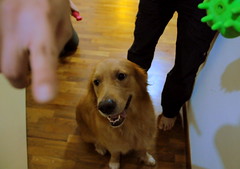
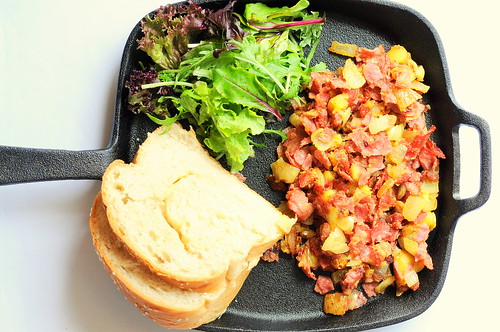
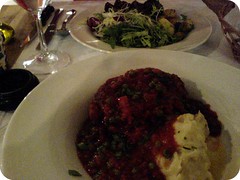
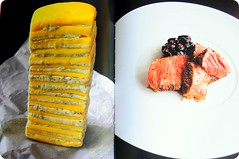
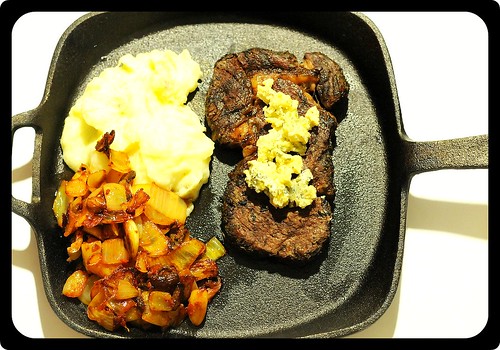








2 Comments:
Hot-looking skillet. Where did you get it?
It was sizzlin' indeed. Got it at Ikea.
Post a Comment
Subscribe to Post Comments [Atom]
<< Home